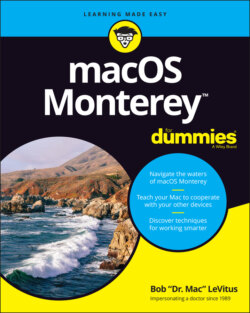Читать книгу macOS Monterey For Dummies - Bob LeVitus - Страница 25
Anatomy of a Window
ОглавлениеWindows are a ubiquitous part of using a Mac. When you open a folder, you see a window. When you write a letter, the document that you’re working on appears in a window. When you browse the internet, web pages appear in a window … and so on.
For the most part, windows are windows from program to program. You’ll probably notice that some programs (Adobe Photoshop or Microsoft Word, for example) take liberties with windows by adding features such as custom toolbars or textual information (such as zoom percentage or file size) around the edges of the document window and in toolbars.
Don’t let it bug you; that extra fluff is just window dressing (pun intended). Maintaining the window metaphor, many information windows display different kinds of information in different panes, or discrete sections within the window.
When you finish this chapter, which focuses exclusively on macOS Finder windows, you’ll know how to use most windows in most applications. And so, without further ado, the following list gives you a look at the main features of a typical Finder window (as shown in Figure 2-1). I discuss these features in greater detail in later sections of this chapter.
If your windows don’t look exactly like Figure 2-1, don’t be concerned. You can make your windows look and feel any way you like. As I explain later in the “Working with Windows” section, moving and resizing windows are easy tasks.
FIGURE 2-1: A typical Finder window in macOS Monterey.
Meanwhile, here’s what you see on the toolbar:
Close, Minimize, and Zoom buttons: Shut ’em, shrink ’em, and grow ’em.
View icons: Choose among four exciting views of your window: Icon, List, Column, and Gallery. Find out more about views in Chapter 4.
Group By menu: Click this little doohickey to group this window’s icons by Name, Kind, Application, Date Modified, Date Created, Date Last Opened, Date Added, Size, or Tags. Or, of course, by None, which is the default.
Action menu: This icon is really a pop-up menu of commands you can apply to currently selected items in the Finder window or on the desktop. It’s nearly the same list of commands you’ll find in the contextual (shortcut) menu when you right-click or Control-click that item or items. Note that some menu icons and items in these menus aren’t available (appear dimmed) until you select one or more icons in the Finder window. If nothing happens when you click a toolbar icon, click a file or folder icon to select it and try again.
Window title: Shows the name of the window (bob in Figure 2-1). ⌘ -click (or Control-click) the window title to see a pop-up menu with the complete path to this folder. (Try it now.) This tip applies to most windows you’ll encounter, not just Finder windows. So ⌘ - or Control-click a window’s title (a right-click or two-fingered tap on a trackpad will work, too), and you’ll (usually) see the path to its enclosing folder on your disk, though some third-party apps don’t follow this convention. To see the path from your hard or solid-state drive to the active window, choose View ⇒ Show Path Bar. The path will appear at the bottom of all Finder windows until you choose View ⇒ Hide Path Bar.
Share menu: Another icon that’s a menu. Click it to share selected files or folders via Mail, Messages, AirDrop, or Notes. Or click More to add other commands to your Share menu, such as Add (the selected item) to Photos or Reminders.
Tags menu: Yet another menu; click it to assign a tag to the selected files or folders.
Search: Click the magnifying glass icon and then type a string of characters in the field that appears. Monterey’s Spotlight search feature digs into your system to find items that match by filename or document contents (yes, it will find words within most documents).
Scroll bars: Use the scroll bars for moving around a window.
Sidebar: Frequently used items live here.
Forward and Back icons: These icons take you to the next or previous folder, respectively, displayed in this particular window. The first time you open a window, neither icon is active; in Figure 2-1, only the Back icon is active.As you navigate from folder to folder, these icons remember your breadcrumb trail so you can quickly traverse backward or forward, window by window. You can also navigate backward or forward from the keyboard by using the shortcuts ⌘ +[ for Back and ⌘ +] for Forward. The Forward and Back icons remember only the other folders you’ve visited in that tab. If you’ve set a Finder preference so that folders always open in a new window — or if you forced a folder to open in a new window, which I describe in a bit — the Forward and Back icons won’t work.
